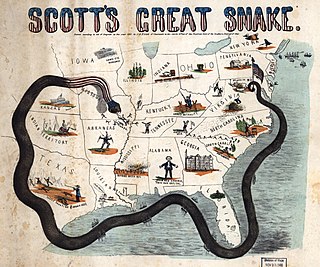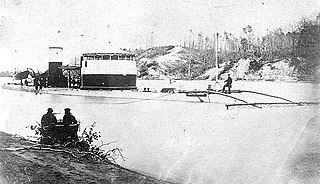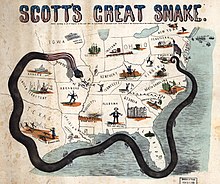
USS Galena was a wooden-hulled broadside ironclad built for the United States Navy during the American Civil War. The ship was initially assigned to the North Atlantic Blockading Squadron and supported Union forces during the Peninsula Campaign in 1862. She was damaged during the Battle of Drewry's Bluff because her armor was too thin to prevent Confederate shots from penetrating. Widely regarded as a failure, Galena was reconstructed without most of her armor in 1863 and transferred to the West Gulf Blockading Squadron in 1864. The ship participated in the Battle of Mobile Bay and the subsequent Siege of Fort Morgan in August. She was briefly transferred to the East Gulf Blockading Squadron in September before she was sent to Philadelphia, Pennsylvania for repairs in November.

The Anaconda Plan is the name applied to a strategy outlined by the Union Army for suppressing the Confederacy at the beginning of the American Civil War. Proposed by Union General-in-Chief Winfield Scott, the plan emphasized a Union blockade of the Southern ports and called for an advance down the Mississippi River to cut the South in two. Because the blockade would be rather passive, it was widely derided by a vociferous faction of Union generals who wanted a more vigorous prosecution of the war and likened it to the coils of an anaconda suffocating its victim. The snake image caught on, giving the proposal its popular name.

USS Canonicus was a single-turret monitor built for the United States Navy during the American Civil War, the lead ship of her class. The ship spent most of her first year in service stationed up the James River, where she could support operations against Richmond and defend against a sortie by the Confederate ironclads of the James River Squadron. She engaged Confederate artillery batteries during the year and later participated in both attacks on Fort Fisher, defending the approaches to Wilmington, North Carolina, from December 1864 to January 1865.

The second USS Augusta was a side-wheel steamer in the United States Navy during the American Civil War. She was named for the city of Augusta, Georgia.

The Battle of Hatteras Inlet Batteries was the first combined operation of the Union Army and Navy in the American Civil War, resulting in Union domination of the strategically important North Carolina Sounds.

USS South Carolina was a steamer used by the Union Navy during the American Civil War.

The first USS Seminole was a steam sloop-of-war in the United States Navy during the American Civil War.

The first USS Pocahontas, a screw steamer built at Medford, Massachusetts in 1852 as City of Boston, and purchased by the Navy at Boston, Massachusetts on 20 March 1855, was the first United States Navy ship to be named for Pocahontas, the Algonquian wife of Virginia colonist John Rolfe. She was originally commissioned as USS Despatch – the second U.S. Navy ship of that name – on 17 January 1856, with Lieutenant T. M. Crossan in command, and was recommissioned and renamed in 1860, seeing action in the American Civil War. As Pocahontas, one of her junior officers was Alfred Thayer Mahan, who would later achieve international fame as a military writer and theorist of naval power.

The Union blockade in the American Civil War was a naval strategy by the United States to prevent the Confederacy from trading.

USS Saugus was a single-turreted Canonicus-class monitor built for the Union Navy during the American Civil War. The vessel was assigned to the James River Flotilla of the North Atlantic Blockading Squadron upon completion in April 1864. The ship spent most of her time stationed up the James River where she could support operations against Richmond and defend against a sortie by the Confederate ironclads of the James River Squadron. She engaged Confederate artillery batteries during the year and later participated in both attacks on Fort Fisher, defending the approaches to Wilmington, North Carolina, in December 1864–January 1865. Saugus returned to the James River after the capture of Fort Fisher and remained there until Richmond, Virginia was occupied in early April.

The Atlantic Blockading Squadron was a unit of the United States Navy created in the early days of the American Civil War to enforce the Union blockade of the ports of the Confederate States. It was formed in 1861 and split up the same year for the creation of the North Atlantic Blockading Squadron and the South Atlantic Blockading Squadron.

The lower seaboard theater of the American Civil War encompassed major military and naval operations that occurred near the coastal areas of the Southeastern United States: in Alabama, Florida, Louisiana, Mississippi, South Carolina, and Texas) as well as southern part of the Mississippi River.

The Battle of Port Royal was one of the earliest amphibious operations of the American Civil War, in which a United States Navy fleet and United States Army expeditionary force captured Port Royal Sound, South Carolina, between Savannah, Georgia and Charleston, South Carolina, on November 7, 1861. The sound was guarded by two forts on opposite sides of the entrance, Fort Walker on Hilton Head Island to the south and Fort Beauregard on Phillip's Island to the north. A small force of four gunboats supported the forts, but did not materially affect the battle.

The First Battle of Charleston Harbor was an engagement near Charleston, South Carolina that took place April 7, 1863, during the American Civil War. The striking force was a fleet of nine ironclad warships of the Union Navy, including seven monitors that were improved versions of the original USS Monitor. A Union Army contingent associated with the attack took no active part in the battle. The ships, under command of Rear Admiral Samuel Francis Du Pont, attacked the Confederate defenses near the entrance to Charleston Harbor. Navy Department officials in Washington hoped for a stunning success that would validate a new form of warfare, with armored warships mounting heavy guns reducing traditional forts.
USS Valparaiso was a Navy vessel that was given a "second life" in her nautical career. During the start of the American Civil War, she was destined to be used as a "stone ship" hazard to navigation sunk in a Southern harbor, but the Union Navy reconsidered and put her to work as a stores ship, supporting the blockade of the ports of the Confederate States of America.

USS Isaac Smith was a screw steamer acquired by the United States Navy during the American Civil War. She was used by the Union Navy to patrol navigable waterways of the Confederate States of America to prevent the Confederacy from trading with other countries. In 1863, she became the only warship in the American Civil War to be captured by enemy land forces. She then served in the Confederate States Navy as CSS Stono until she was wrecked.
USS Bloomer was a stern-wheel steamer acquired by the Union Navy during the American Civil War. She was used by the Union Navy as a gunboat with orders to patrol navigable waterways of the Confederacy to prevent the South from trading with other countries.
The Confederate privateers were privately owned ships that were authorized by the government of the Confederate States of America to attack the shipping of the United States. Although the appeal was to profit by capturing merchant vessels and seizing their cargoes, the government was most interested in diverting the efforts of the Union Navy away from the blockade of Southern ports, and perhaps to encourage European intervention in the conflict.

The blockade runners of the American Civil War were seagoing steam ships that were used to get through the Union blockade that extended some 3,500 miles (5,600 km) along the Atlantic and Gulf of Mexico coastlines and the lower Mississippi River. The Confederate states were largely without industrial capability and could not provide the quantity of arms and other supplies needed to fight against the industrial north. To meet this need blockade runners were built in Scotland and England and were used to import the guns, ordnance and other supplies that the Confederacy desperately needed, in exchange for cotton that the British textile industry needed greatly. To penetrate the blockade, these relatively lightweight shallow draft ships, mostly built in British ship yards and specially designed for speed but incapable of carrying much cotton, had to cruise undetected, usually at night, through the Union blockade. The typical blockade runners were privately owned vessels often operating with a letter of marque issued by the Confederate States of America. If spotted, the blockade runners would attempt to outmaneuver or simply outrun any Union ships on blockade patrol, often successfully.

















